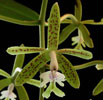|
|
|
|
|
| |
Flasks of
Epidendrum cristatum 'Judy Greenlee' AM/AOS × self |
|
| |
|
|
| |
|
|
Click to Enlarge

Pod Parent Flower |
Click to Enlarge

Offspring 'MC5278' Flower |
| Offspring photos are siblings of the plants you would receive. |
|
|
|
| |
Culture Notes from Donor: Parent plant: Grown in bright light with only a slight reduction in water during the winter. Temperatures 55-90°F. Robust, easily grown plant.
Comments: Parent plant: For me, this is a robust easy growing plant. Large plant. A reed stem type Epidendrum growing 1 meter tall. Pendulous inflorescences with 50 or more 5.5 cm flowers. Old canes rebloom for several years.
For additional origin/habitat information supplied courtesy of
Charles and Margaret Baker, see further below, near the bottom of this page.
|
Temperatures we attempt to use in the lab & greenhouse:
| For Species: |
|
Spring, Summer, Autumn, Winter: days average 83°F, nights 61°F; best fit is Intermediate 83-60°F
(Source:
Baker's Web OSC) |
|
About the name...
| Etymology of |
cristatum |
|
From Latin "cristatus" with a comb, a callus.
(Source:
Mayr & Schmucker 1998) |
| Etymology of |
Epidendrum |
|
From Greek "epi" upon; "dendron" tree.
(Source:
Pridgeon 1992) |
| Pronunciation of |
Epidendrum |
|
eh-pee-DEN-drum
(Source:
Pridgeon 1992) |
|
If you would like to direct someone to this web page, please copy and paste this URL into your email:
http://troymeyers.com/d?016937
| Flask Information |
| Availability: |
We have sold all of the flasks for this item. |
| You should: |
Consider getting individual plants or compots instead of a flask.
You can place a "Notify Flask Recipients" Request, and either we or a flask recipient may contact you when plants are available.
You may also place a "Notify Retries" Request, and if an identical pollination (the same parents) is done again, we'll let you know.
You may reserve a flask, but it's very unlikely you'll get one ...this could only happen if we found a flask that we didn't know we had. |
| Yield Estimate: |
478 plants (based on flask surveys done 05/13/2011 through 06/27/2019)
|
| Plantlet Sizes: |
From many flasks 5 - 85 mm plants (based on flask surveys done 05/13/2011 through 04/17/2020)
From one most recently surveyed flask 30 - 80 mm (04/17/2020)
|
|
You might also want to:
|
View the seed assay for this item.
View items of the same species.
View items of the same genus.
|
| Ordering Information |
| You are not currently logged in. |
|
You must be a registered user and be logged in to reserve a flask or place a notification request. Please log in:
|
|
|
|
|
|
| |
The origin/habitat information below is supplied courtesy of Charles and Margaret Baker
The following information is based on the name of the plant provided by the donor, and assumes that the name is correct. If the plant has been misidentified, then the following information may not be correct.
This text is copyrighted by the Bakers and may not be reproduced without permission.
ORIGIN/HABITAT: Colombia, Venezuela, Guyana, Surinam, Brazil, Ecuador,
Peru, and Bolivia. In Venezuela, plants have been found in the state of
Anzoateui at about 1650 ft. (500 m), in the state of Bolívar at 750-1950
ft. (230-600 m), in the state of Monagas near Caripe where they were
growing in cloudforest at about 2000 ft. (610 m), and in the state of
Sucre as well as in the Federal District near Caracas, but details of
habitat elevation in these areas were not reported. Plants have been found
in Brazil in the states of Minas Gerais and Paraná, but details of habitat
location and elevation were not given. In Ecuador plants have were found
in earlier years in Pichincha Province near Santo Domingo at (530 m) and
in Zamora-Chinchipe Province between Loja and Zamora at 5250 ft. (1600 m)
and near Zamora at 3600-6250 ft. (1100-1600 m). More recently, however, a
collection has been made in Napo Province at 1500 ft. (450 m). In Peru,
plants have been found in the department of Pasco near Oxapampa at 3300
ft. (1000 m), in Amazonas near Bagua at 3600 ft. (1100 m), and in Junín
near Chanchamayo at 1800 ft. (550 m). Recent collections have been made in
the department of Cajamarca in the Cordillera del Condor at (690-1300).
Collections have been made in Bolivia in the department of Beni at 800 ft.
(250 m). Collections have also been reported from Trinidad, but no details
were given.
More about this information and the Bakers...
|
|
|
| |
|
|
|